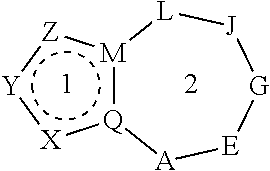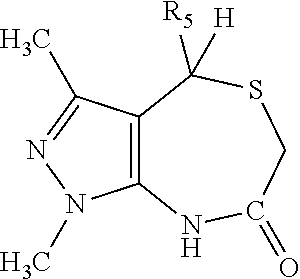Heterocyclic nuclear hormone receptor modulators
a hormone receptor and nuclear technology, applied in heterocyclic compound active ingredients, drug compositions, immunological disorders, etc., can solve the problem of limited use of gc agonists in chronic settings
- Summary
- Abstract
- Description
- Claims
- Application Information
AI Technical Summary
Benefits of technology
Problems solved by technology
Method used
Image
Examples
examples
[0507]None of the specific conditions and reagents noted herein are to be construed as limiting the scope of the invention and are provided for illustrative purposes only. All starting materials are commercially available from Sigma-Aldrich (including Fluka and Discovery CPR) unless otherwise noted after the chemical name. Reagent / reactant names given are as named on the commercial bottle or as generated by IUPAC conventions, CambridgeSoft® Chemdraw Ultra 9.0.7 or AutoNom 2000. Compounds designated as salts (e.g. hydrochloride, acetate) may contain more than one molar equivalent of the salt.
Abbreviations
[0508]aa Amino acids[0509]Ac2O Acetic anhydride[0510]AcOH Glacial acetic acid[0511]atm Atmospheres[0512]ATP Adenosine triphosphate[0513]b.p. Boiling point[0514]BArF tetrakis-[3,5-bis(trifluoromethyl)phenyl]borate[0515]Bn Benzyl[0516]Boc t-Butoxycarbonyl[0517]BOP-Cl Bis(2-oxo-3-oxazolidinyl)phosphonic chloride[0518]br. Broad[0519]br. d Broad doublet[0520]br., s Broad singlet[0521]bs B...
preparation # 7
Preparation #7
5-methoxy-2-methyl-benzaldehyde
[0740]
[0741]To a degassed solution of 2-bromo-5-methoxybenzaldehyde (1.5 g, 7.04 mmol, Fluorochem) and trimethylboroxine (0.98 mL, 7.04 mmol) in 1,4-dioxane (80 mL) was added potassium carbonate (2.91 g, 21.1 mmol) and tetrakis(triphenylphosphine)palladium(0) (0.813 g, 0.70 mmol). The mixture was heated under reflux for about 20 h, then more tetrakis(triphenylphosphine)palladium(0) (0.200 g, 0.17 mmol) and trimethylboroxine (0.25 mL, 1.8 mmol) were added and the mixture was heated under reflux for about another 3 h. After cooling to rt the mixture was filtered over diatomaceous earth and concentrated in vacuo. The residue was purified by column chromatography (SiO2, diethyl ether / hexanes 1:3) to give 5-methoxy-2-methyl-benzaldehyde (0.97 g, 92%) as a colorless liquid. 1H-NMR (CDCl3, Bruker 400 MHz) 2.60 (3 H, s); 3.83 (3 H, s); 7.04 (1 H, dd, J=8.5 Hz, 2.4 Hz); 7.16 (1 H, d, J=8.5 Hz); 7.33 (1 H, d, J=2.4 Hz); 10.2 (1 H, s).
preparation # 8
Preparation #8
methyl 3-methylisoxazole-5-carboxylate
[0742]
[0743]To a solution of N-chlorosuccinimide (2.67 g, 20 mmol) and pyridine (0.1 mL) in chloroform (18 mL), was added, portionwise, acetaldehyde oxime (1.18 g, 20 mmol), at about 5° C. After complete addition the mixture was stirred at rt for about 10 min and then methyl propiolate (2.22 mL, 25 mmol) was added. Subsequently, a solution of triethylamine (2.92 mL, 21 mmol) in chloroform (3 mL) was added dropwise, at such a rate that the temperature was maintained between 15 and 18° C. After complete addition the mixture was stirred at about 18° C. for about 20 min, then water (15 mL) was added. The layers were separated and the organic layer was washed with water (15 mL), dried (MgSO4), filtered, and concentrated in vacuo. The residue was treated with diethyl ether (20 mL) and the formed precipitate was collected by filtration and dried to give methyl 3-methylisoxazole-5-carboxylate (1.75 g, 12.4 mmol, 62%) as a brown solid whic...
PUM
| Property | Measurement | Unit |
|---|---|---|
| width | aaaaa | aaaaa |
| run time | aaaaa | aaaaa |
| run time | aaaaa | aaaaa |
Abstract
Description
Claims
Application Information
 Login to View More
Login to View More - R&D
- Intellectual Property
- Life Sciences
- Materials
- Tech Scout
- Unparalleled Data Quality
- Higher Quality Content
- 60% Fewer Hallucinations
Browse by: Latest US Patents, China's latest patents, Technical Efficacy Thesaurus, Application Domain, Technology Topic, Popular Technical Reports.
© 2025 PatSnap. All rights reserved.Legal|Privacy policy|Modern Slavery Act Transparency Statement|Sitemap|About US| Contact US: help@patsnap.com



